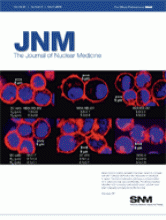REPLY: We thank Dr. Chiu et al. for their interest in our recent investigation on the impact of intravenous insulin on 18F-FDG PET in diabetic cancer patients (1), and we would like to address their concerns.
The decision to use a 10.0 mmol/L threshold for insulin administration was based on the expected limited influence of this glycemia level on 18F-FDG uptake and on the fact that it approaches the Km value of glucose transporter 3 (2). The Society of Nuclear Medicine guidelines state that most institutions reschedule the patient if the blood glucose level is greater than 8.3–11.1 mmol/L (3). The European Association of Nuclear Medicine does not recommend proceeding with an 18F-FDG PET study when the glucose level in the blood exceeds 11.1 mmol/L (4). Choosing a higher threshold could reduce PET sensitivity. Choosing a lower threshold will increase the number of patients receiving insulin. We found no significant correlation between the initial glycemia and image quality. We disagree that “the set point to prescribe insulin in the study protocol of Roy et al. might account for their poor image quality.” Turcotte et al. used a lower threshold (7.0 mmol/L) and showed no significant increase in muscular uptake (5).
The guidelines of the Society of Nuclear Medicine mention that administering insulin can be considered, although the administration of 18F-FDG would have to be delayed after insulin administration (3). This is in keeping with our finding that the interval between insulin and 18F-FDG injection is a critical factor for image quality when insulin is administered. 18F-FDG biodistribution was adequate in 75% of patients injected with insulin. This was not a “barely” adequate biodistribution as suggested by the author, but a normal or near-normal biodistribution. Administration of insulin in these patients allowed them to have a diagnostic 18F-FDG PET study. Rescheduling PET scans is inconvenient for patients and delays investigation and treatment. Improvement of 18F-FDG biodistribution in the remaining 25% of patients will certainly require systematic postponing of 18F-FDG administration until at least 90 min after insulin injection.
We entirely agree with Dr. Chiu et al. that a better way to ensure adequate glycemia the day of the PET scan is to “do a ‘practice run’ by checking the patient's blood glucose levels for at least 3 d before the 18F-FDG PET appointment.” As we noted in the “Discussion” section of our article, “even with adequate recommendations, some patients will reach the department with elevated glycemia” (1). Calling our protocol a “risky strategy” seems exaggerated. We agree that intravenous insulin requires close medical surveillance, as provided for in our protocol. Six patients experienced hypoglycemia (9.5%), as defined by a glycemic level measured at 3.5 mmol/L or lower by glucometer. Moreover, the 2 patients who presented symptoms responded rapidly to oral glucose. Rescheduling PET is certainly a “no-risk” situation for the PET physician. However, some patients will require a few weeks before being able to reach adequate glycemia. The hypoglycemia risk associated with insulin use should always be balanced with the risk of delayed management. To address the issue of transcellular-shift hypokalemia, we recommended that patients with glycemia above 15 mmol/L should be rescheduled. We fully agree that there is nonuniform insulin sensitivity among hyperglycemic patients. The aim of this insulin administration, using a sliding scale, was to rapidly control the level of insulin before 18F-FDG administration in hyperglycemic patients. It was never intended to manage diabetes or to replace any treatment regimen. In clinical PET practice, the insulin dose should be modulated according to patient profile.
In conclusion, we insist that our study sought to evaluate the safety and effectiveness of insulin administration to reduce glycemia in diabetic cancer patients who display elevated glycemia despite recommendations. We used a pragmatic approach to minimize the need to reschedule patients, reduce the risk of false-negative PET results due to hyperglycemia, and limit the hazards associated with insulin administration in patients with moderately elevated glycemia (10.0–15.0 mmol/L).
Footnotes
-
COPYRIGHT © 2010 by the Society of Nuclear Medicine, Inc.







